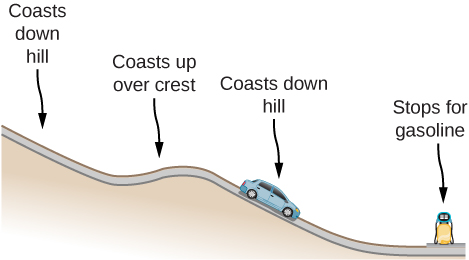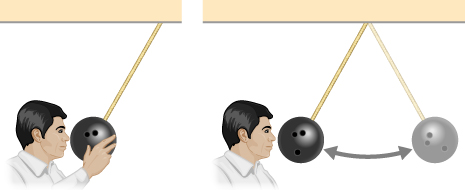| << Chapter < Page | Chapter >> Page > |
Systems generally consist of more than one particle or object. However, the conservation of mechanical energy, in one of the forms in [link] or [link] , is a fundamental law of physics and applies to any system. You just have to include the kinetic and potential energies of all the particles, and the work done by all the non-conservative forces acting on them. Until you learn more about the dynamics of systems composed of many particles, in Linear Momentum and Collisions , Fixed-Axis Rotation , and Angular Momentum , it is better to postpone discussing the application of energy conservation to then.
When a body slides down an inclined plane, does the work of friction depend on the body’s initial speed? Answer the same question for a body sliding down a curved surface.
Consider the following scenario. A car for which friction is not negligible accelerates from rest down a hill, running out of gasoline after a short distance (see below). The driver lets the car coast farther down the hill, then up and over a small crest. He then coasts down that hill into a gas station, where he brakes to a stop and fills the tank with gasoline. Identify the forms of energy the car has, and how they are changed and transferred in this series of events.

The car experiences a change in gravitational potential energy as it goes down the hills because the vertical distance is decreasing. Some of this change of gravitational potential energy will be taken away by work done by friction. The rest of the energy results in a kinetic energy increase, making the car go faster. Lastly, the car brakes and will lose its kinetic energy to the work done by braking to a stop.
A dropped ball bounces to one-half its original height. Discuss the energy transformations that take place.
“ constant is a special case of the work-energy theorem.” Discuss this statement.
It states that total energy of the system E is conserved as long as there are no non-conservative forces acting on the object.
In a common physics demonstration, a bowling ball is suspended from the ceiling by a rope.
The professor pulls the ball away from its equilibrium position and holds it adjacent to his nose, as shown below. He releases the ball so that it swings directly away from him. Does he get struck by the ball on its return swing? What is he trying to show in this demonstration?


Notification Switch
Would you like to follow the 'University physics volume 1' conversation and receive update notifications?